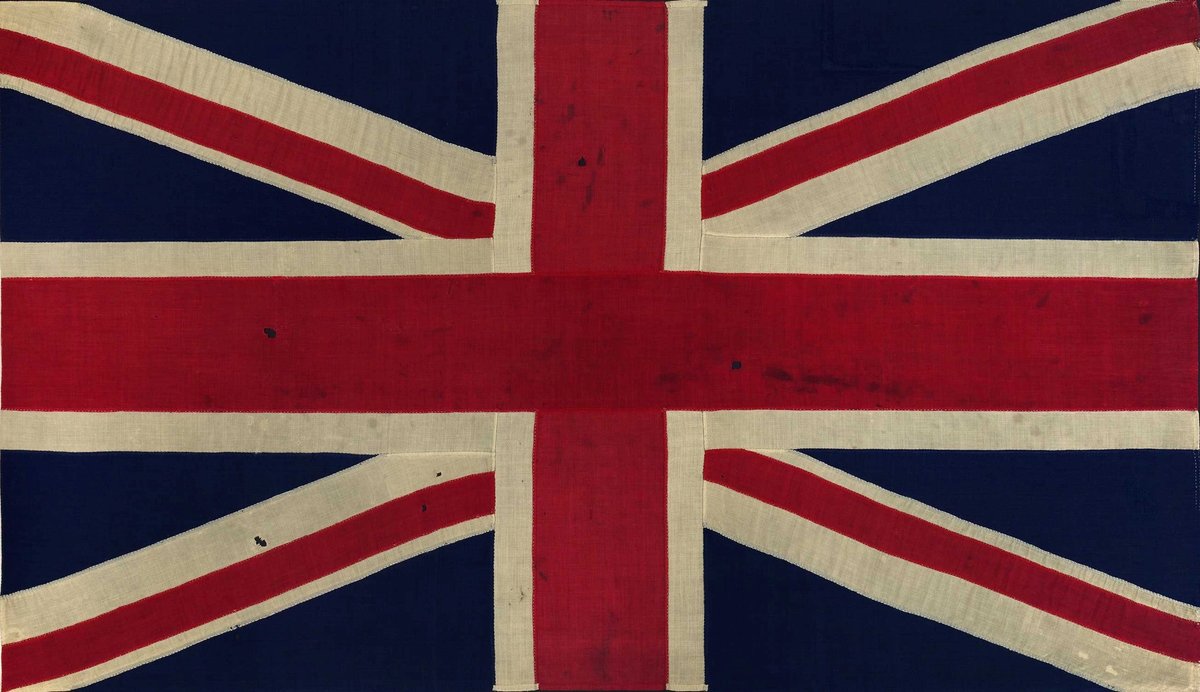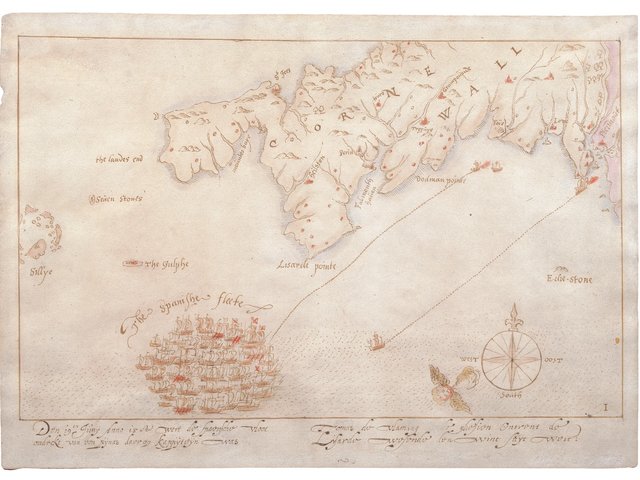A Union flag which flew from the ship that led the British fleet into the Battle of Trafalgar on 21 October 1805, the day of the victory and the death of Admiral Horatio Nelson, will be offered for sale at the Treasure House Fair this month. Priced at £450,000, it is believed to be the most important flag from the battle still in private hands.
The flag flew on the Royal Sovereign, captained by Nelson’s friend and second in command, Admiral Cuthbert Collingwood, after Nelson ordered all his ships to set Union as well as squadron flags to avoid confusion in the thick of battle. As the fastest ship, swifter than Nelson’s Victory, she led the fleet and at one point in the battle was fighting off six encircling Spanish ships. The Royal Sovereign was badly damaged, and Collingwood himself was injured in the battle. Nelson, who had insisted on remaining on deck on Victory—clearly identified by his uniform despite urging from his officers—was fatally injured by a French sniper and lived just long enough to learn of his fleet’s triumph.
I am not saying there are no more out there, but I am saying this is an object of the highest importance
The Royal Sovereign flag is being sold for only the second time. It remained in the family of Charles Aubrey Antram, one of the ship’s officers, until the 1970s. It was then given to William Ames, a family friend who died in 2003, and then sold privately. The flag will now be exhibited and sold at the fair by the dealer Greens of Cheltenham.
Sold for a few hundred pounds
The flag has been newly identified as a precious relic from Trafalgar by Martyn Downer, an expert on Nelson and naval memorabilia. When it was last sold in 2003, it went for a few hundred pounds— “no money at all”, Downer says—because its provenance had become confused. The Antram family believed it came from another famous Nelson victory, the 1798 Battle of the Nile, in which Charles Antram’s brother fought. But Downer noted that Nelson’s command that his ships fly the Union flag was unique at Trafalgar, and that the familiar version of the flag did not exist in 1798.
The flag may have been made on board the Royal Sovereign, Downer says, since Union flags were not part of ships’ official kit, and the captains would have had to obtain or make them to carry out Nelson’s orders. A crucial part of the identification was a small lead weight in the upper free corner of the flag as shown in a contemporary image of Royal Sovereign at Trafalgar. The flag was flown vertically from the fore spar (mast), not horizontally, and the weight helped ensure that it hung properly instead of wrapping itself around the spar.
Only three Union flags from the battle have been identified: one from HMS Spartiate; one from HMS Minotaur, which had been preserved in a church and is now on display at the National Mari-time Museum in Greenwich; and this one. “I am not saying there are no more out there,” Downer says, “but I am saying this is an object of the highest rarity and importance.”
High demand for Trafalgar relics
Flags are among the Trafalgar relics most coveted by collectors—last year a few playing card sized scraps of wool sold for almost £10,000. The record was set in 2009, when auctioneers Charles Miller sold the Union flag from HMS Spartiate for £396,800, wildly exceeding the top estimate of £15,000.
Collingwood became commander-in-chief after Nelson’s death, but his health steadily worsened, and he died at sea on his way back to England in 1810. He was buried close to his friend Nelson in the crypt of St Paul’s Cathedral. The Royal Sovereign was repaired and returned to service after the Battle of Trafalgar, before being broken up in 1841, unlike the Victory, which was preserved by a wave of patriotic sentiment over the battle. Now undergoing restoration work, the Victory has been a museum in dry dock in Portsmouth Historic Dockyard since 1922, but is still part of the Royal Navy, the official flagship of the First Sea Lord.
Scraps occasionally appear in sales of the most famous flag from the battle, from the Victory. It draped Nelson’s coffin at his funeral in London in January 1806, after his body was sent back to England preserved in a cask of brandy. In a huge state funeral, the coffin was dragged by sailors through the streets on an elaborate hearse, and after the ceremony they tore the flag to shreds to keep as souvenirs.
• Treasure House Fair, Royal Hospital Chelsea, London, 26 June-1 July





